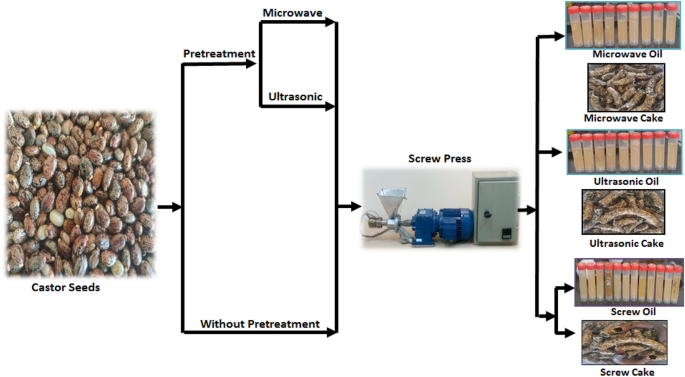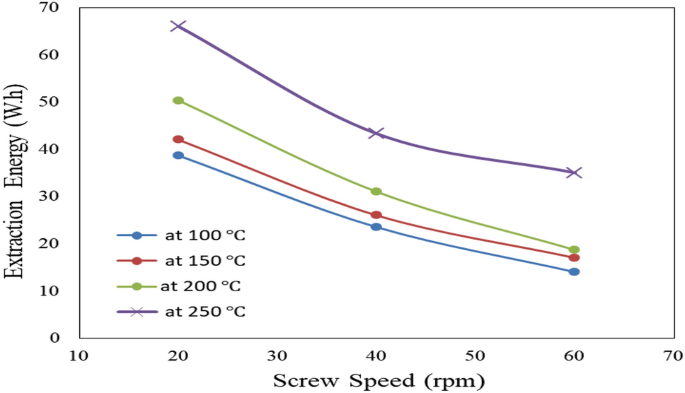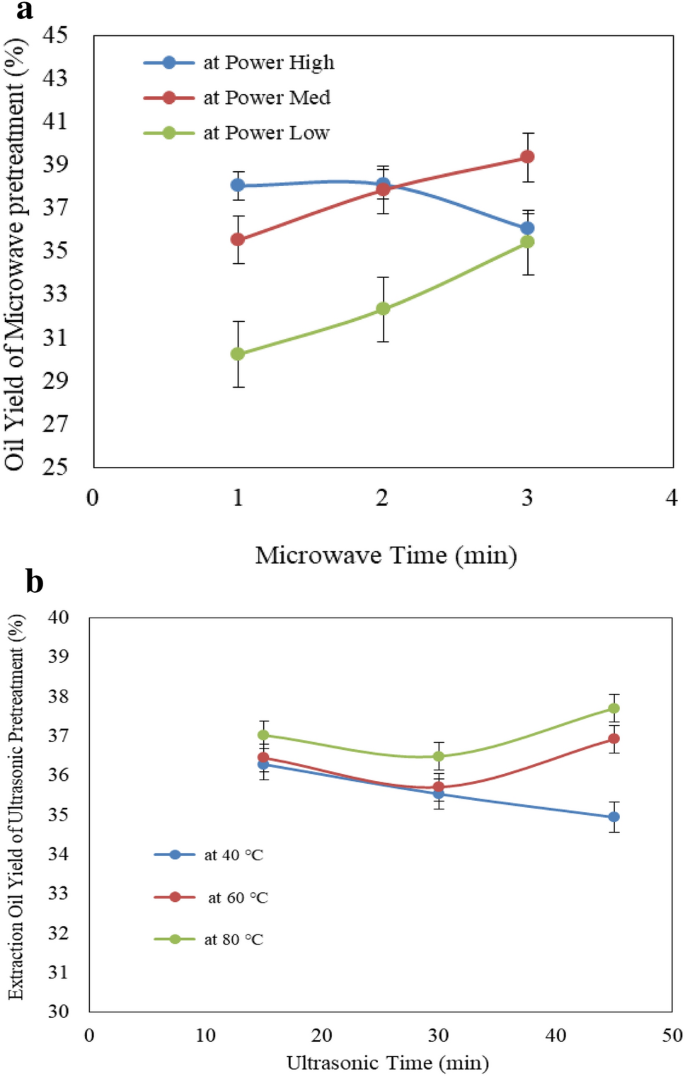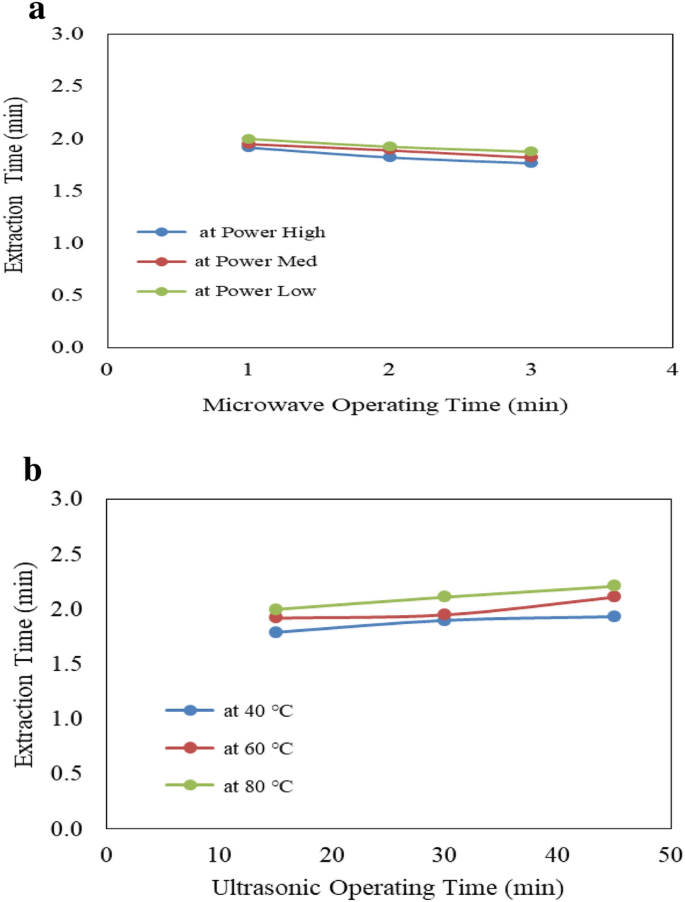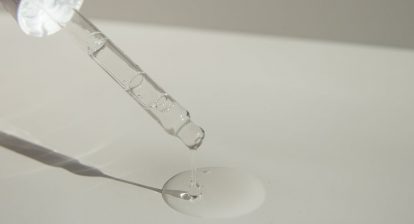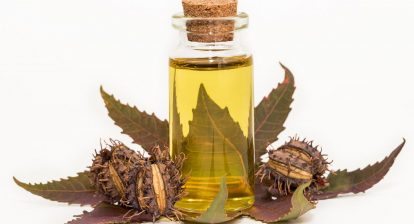Screw press conditions
Effect of extraction screw speed and temperature on oil extracted yield
Figure 5 shows the effect of extraction screw speed (20, 40 and 60 rpm) and temperature (100, 150, 200 and 250 °C) on oil yield from castor seeds. The results indicate that the oil yield decreases with increasing screw speed and decreasing temperature. It could be seen that the oil yield decreased from 37.66 to 30.13 (by 19.99%), 38.13 to 31.88 (by 16.39%), 39.24 to 35.59 (by 9.30%) and 40.85 to 30.37 (by 25.65%) % when the screw speed increased from 20 to 60 rpm, respectively, for 100, 150, 200 and 250 °C. The results also indicate that the highest value of decreasing of oil extraction yield (25.65%) was found for 250 °C extraction temperature. This was may be due to that with higher temperature, the oil exit from the cell easy17.
Also, the high temperature causes evaporate the oil from the cell, which leads to a decrease of oil yield. These results agreed with those obtained by16 whose found the lowest value of oil yield extraction was found the highest value of extraction temperature. The results indicate that the maximum oil production is about 40.84% by the screw press which is equivalent to 83.41% by mass fraction of oil in seeds in comparison percentage oil 48.96% in seeds obtained at an engine speed of 20 rpm and preheating temperature of 250 °C. These results agreed with those obtained by1. However, in these extraction conditions, much time is consumed with higher energy. The maximum yield of oil (40.85%) was obtained at temperatures in the range of 250 °C at speed of 20 rpm.
Effect of extraction screw speed and temperature on extraction energy consumption
Figure 6 shows the effect of extraction screw speed (20, 40 and 60 rpm) and temperature (100, 150, 200 and 250 °C) on oil extraction energy consumption from castor seeds. The results indicate that the extraction energy consumption decreases with increasing screw speed and decreasing temperature. It could be seen that the extraction energy consumption decreased from 38.67 to 14.00 (by 63.80%), 42.00 to 17.00 (by 59.52%), 50.33 to 18.67 (by 62.90%) and 66.00 to 35.00 (by 46.97%) W.h when the screw speed increased from 20 to 60 rpm for 100, 150, 200 and 250 °C, respectively. The results also indicate that the highest value of extraction energy consumption (66.00 W.h) was found of 250 °C extraction temperature and 20 rpm screw speed, while, the lowest value of extraction energy consumption (14.00 W.h) was found of 100 °C extraction temperature and 60 rpm screw speed. These results agreed with those obtained by20.
Effect of extraction screw speed and temperature on extraction time
Figure 7 shows the effect of extraction screw speed (20, 40 and 60 rpm) and temperature (100, 150, 200 and 250 °C) on oil extraction time from castor seeds. The results indicate that the extraction time decreases with increasing screw speed and decreasing temperature. It could be seen that the extraction time decreased from 5.00 to 1.59 (by 68.20%), 5.25 to 1.70 (by 67.62%), 5.76 to 1.86 (by 67.71%) and 6.45 to 2.68 (by 58.45%) min when the screw speed increased from 20 to 60 rpm for 100, 150, 200 and 250 °C, respectively. The results also indicate that the highest value of extraction time (6.45 min) was found of 250 °C extraction temperature and 20 rpm screw speed, while, the lowest value of extraction time (1.59 min) was found of 100 °C extraction temperature and 60 rpm screw speed. These results agreed with those obtained by21.
The results indicate that the optimum conditions of screw press for extracted caster seeds were 200 °C extraction temperature and 60 rpm screw speed. It could be seen that the extraction oil yield, extraction energy and extraction time were 35.59%, 18.68 and 1.86 min, respectively.
Pretreatment condition
Effect of pretreatment conditions (microwave and ultrasonic) on oil extraction yield
Figure 8a shows the effect of microwave power level (low, medium and high) and operating time (1, 2 and 3 min) on oil extraction yield from castor seeds. The results indicate that the oil extraction yield increases with increasing operating time for low and medium microwave power levels and it decreases with increasing operating time for high microwave power level. It could be seen that the oil extraction yield increased from 30.24 to 35.43 and 35.54 to 39.36% when the operating time increased from 1 to 3 min, respectively for low and medium microwave power levels, respectively. Meanwhile, it was decreased from 38.05 to 36.06% when the operating time increased from 1 to 3 min, respectively, for high microwave power level. This is due to the high microwave power level causes evaporation oil moisture from the cell, which leads to a decrease of oil yield. The results also indicate that the highest value of oil extraction yield (39.36%) was found of 3 min operating time and medium microwave power level compared non-treatment, the oil extraction yield was 35.59% at the same conditions (200 °C extraction temperature and 60 rpm screw speed).
Figure 8b shows the effect of ultrasonic temperature (40, 60 and 80 °C) and operating time (15, 30 and 45 min) on oil extraction yield from castor seeds. The results indicate that the oil extraction yield values were 36.26, 35.54 and 34.95, 36.46, 35.71 and 36.93 and 37.03, 36.50 and 37.71% at 15, 30 and 45 min operating time, respectively for 40, 60 and 80 °C ultrasonic temperatures. The results also indicate that the highest value of oil extraction yield (37.03%) was found of 15 min operating time and 80 °C ultrasonic temperature compared non-treatment.
The results also indicate that the oil extraction yield from castor seeds by using microwave pretreatment was higher than those of ultrasonic pretreatment for medium and high power levels and medium and high temperature, while the oil extraction yield from caster seeds by using microwave pretreatment was lower than those of ultrasonic pretreatment for low power levels and low temperatures. It could be seen that the oil extraction yield values were 32.67, 37.59 and 37.41% for low, medium and high microwave power levels, respectively, but they were 35.59, 36.37 and 37.08% for 40, 60 and 80 °C ultrasonic temperature, respectively. Also, the oil extraction yield form castor seeds by using microwave pretreatment were higher than those of ultrasonic pretreatment for medium and high operating time, while the oil extraction yield for extracted castor seeds from castor seeds by using microwave pretreatment was lower than those of ultrasonic pretreatment for low operating time. It could be seen that the oil extraction yield values were 34.61, 36.10 and 36.95% for 1, 2 and 3 min microwave operating time, respectively, but they were 36.59, 35.92 and 36.53% for 15, 30 and 45 min ultrasonic operating time, respectively. Generally, the oil yield from castor seeds ranged from 32.67 to 37.41% compared to 13.29 to 39.83% in literature22.
Effect of pretreatment condition (microwave and ultrasonic) on extraction energy consumption
Figure 9a shows the effect of microwave power (low, medium and high) and operating time (1, 2 and 3 min) on extraction energy consumption from castor seeds. The results indicate that the extraction energy consumption decreases with increasing microwave power level and operating time. It could be seen that the extraction energy consumption decreased from 21.0 to 19.0, 20.0 to 18.0 and 19.0 to 16.5 W.h when the operating time increased from 1 to 3 min, respectively for low, medium and high microwave power levels. On the other hand, the energy consumed by microwave increases with increasing microwave power level and operating time. It could be seen that the energy consumed by microwave increased from 4.33 to 10.67, 14.00 to 40.00 and 17.67 to 51.67 W.h when the operating time increased from 1 to 3 min, respectively for low, medium and high microwave power levels. The results also indicate that the highest value of extraction energy (21.0 W.h) was found of 1 min operating time and low microwave power level. While, the lowest value of extraction energy (16.5 W h) was found of 3 min operating time and high microwave power level.
Figure 9b shows the effect of ultrasonic temperatures (40, 60 and 80 °C) and operating time (15, 30 and 45 min) on extraction energy consumption from castor seeds. The results indicate that the extraction energy consumption increases with increasing ultrasonic temperature and operating time. It could be seen that the extraction energy consumption increased from 18.0 to 20.0, 19.0 to 21.0 and 20.0 to 22.0 W h when the operating time increased from 15 to 45 min, respectively for 40, 60 and 80 °C ultrasonic temperature. While, the energy consumed by ultrasonic increases with increasing ultrasonic temperature and operating time. It could be seen that the energy consumed by ultrasonic increased from 11.00 to 34.95, 12.40 to 36.33 and 16.33 to 38.00 W h when the operating time increased from 15 to 45 min, respectively for 40, 60 and 80 °C ultrasonic temperature. The results also indicate that the highest value of extraction energy consumption (38.0 W h) was found of 45 min operating time and 80 °C ultrasonic temperature. While, the lowest value of extraction energy consumption (18.0 W h) was found of 15 min operating time and 40 °C ultrasonic temperature.
The results also indicate that the extraction energy consumption from castor seeds by using microwave pretreatment were lower than those of ultrasonic pretreatment. It could be seen that the extraction energy consumption from castor seeds were 20.0, 19.0 and 17.5 W h for low, medium and high microwave power levels, respectively, but they were 19.17, 20.17 and 21.00 W.h for 40, 60 and 80 °C ultrasonic temperature, respectively. Also, the extraction energy consumption from castor seeds by using microwave pretreatment was higher than those of ultrasonic pretreatment for medium and high operating time, while the extraction energy by using microwave pretreatment was lower than those of ultrasonic pretreatment for low operating time. It could be seen that the extraction energy consumption were 20.0, 19.0 and 17.33 W h for 1, 2 and 3 min microwave operating time, respectively, but they were 19.0, 20.3 and 21.0 W h for 15, 30 and 45 min ultrasonic operating time, respectively.
Effect of pretreatment conditions (microwave and ultrasonic) on extraction time
Figure 10a shows the effect of microwave power level (low, medium and high) and operating time (1, 2 and 3 min) on extraction time from castor seeds. The results indicate that the extraction time decreases with increasing microwave power level and operating time. It could be seen that the extraction time decreased from 2.00 to 1.88, 1.95 to 18.82 and 1.92 to 1.77 min when the operating time increased from 1 to 3 min, respectively for low, medium and high microwave power levels. The results also indicate that the highest value of extraction time (2.0 min) was found of 1 min operating time and low microwave power level. While, the lowest value of extraction time (1.77 min) was found of 3 min operating time and high microwave power level.
Figure 10b shows the effect of ultrasonic temperatures (40, 60 and 80 °C) and operating time (15, 30 and 45 min) on extraction time from castor seeds. The results indicate that the extraction time increases with increasing ultrasonic temperature and operating time. It could be seen that the extraction time increased from 1.79 to 1.93, 1.92 to 2.11 and 2.00 to 2.21 min when the operating time increased from 15 to 45 min, respectively for 40, 60 and 80 °C ultrasonic temperature. The results also indicate that the highest value of extraction time (2.21 min) was found of 45 min operating time and 80 °C ultrasonic temperature. While, the lowest value of extraction time (1.79 min) was found of 15 min operating time and 40 °C ultrasonic temperature.
Gas chromatography analysis
Table 1 shows the effect of pretreatment (microwave and ultrasonic) of castor seeds on the gas chromatography analysis compared to without pretreatment on the same conditions (200 °C extraction temperature and 60 rpm screw speed). The results indicate that, using of microwave for pretreatment of castor seeds was enhanced contents of oil yield properties more than those of ultrasonic pretreatment for castor seeds and without pretreatment. On the other hand, using of ultrasonic for pretreatment of castor seeds was enhanced quality of oil properties more than those of microwave pretreatment for castor seeds and without pretreatment. It could be seen that the Palmitic acid, Stearic acid, Oleic acid, Linolenic acid and α Linolenic acid were 1.26, 1.76 and 0.77, 1.35, 2.61 and 1.09, 4.47, 5.12 and 3.43, 5.41, 6.53 and 4.17 and 0.62, 0.54 and 0.49% for non-treatment, microwave pretreatment and ultrasonic pretreatment, respectively. These results agreed with those obtained by23,24 whose found that the castor oil is presents in minor amount that includes Stearic acid (1%), Linoleic acid (4.2%), Linolenic acid (0.3%), Dihydroxystearic acid (0.7%),Oleic acid (3.0%), Palmitic acid (1%), and Eicosanoic acid (0.3%)17.
The results also indicate that the Ricinoleic acid was 86.99, 83.44 and 90.05% for non-treatment, microwave pretreatment and ultrasonic pretreatment, respectively. These results agreed with those obtained by6 whose mentioned that the Ricinoleic acid is a major component of the castor seed oil where About 90% of the fatty acid content in castor oil is the triglyceride formed from Ricinoleic acid. It is an unsaturated omega-9 fatty acid and a hydroxy acid.
The results indicate that the acid values were 1.56, 2.11 and 1.13% for non-treatment, microwave pretreatment and ultrasonic pretreatment, respectively. Acid value is one of the important indicators of oil quality26. Omari et al.27 suggested that the high acid value of castor oil may be due to the delay in seed extraction which influenced the lipase enzyme to hydrolyze the triglycerides into free fatty acid25.
Saponification number values were 179.9, 178.7 and 182.4 for non-treatment, microwave pretreatment and ultrasonic pretreatment, respectively. These results agreed with those obtained by7,25. Also, the physicochemical properties of oil such as low acid value and free fatty acid percentage, high saponification value acid indicate that castor oil has good oil quality.
The molecular weight (MW) of oil value were 943.70, 953.06 and 928.45 for non-treatment, microwave pretreatment and ultrasonic pretreatment, respectively. The raw materials are converted into biodiesel through a chemical reaction involving alcohol and a catalyst. The specification of the molecular weight of crop oil is important for the biodiesel production process because the determination of the quantity of reactants is calculated according to the molecular weight of castor oil28. The results indicate that the lowest and the best of the molecular weight (MW) of oil value ultrasonic pretreatment then without pretreatment then microwave pretreatment.

